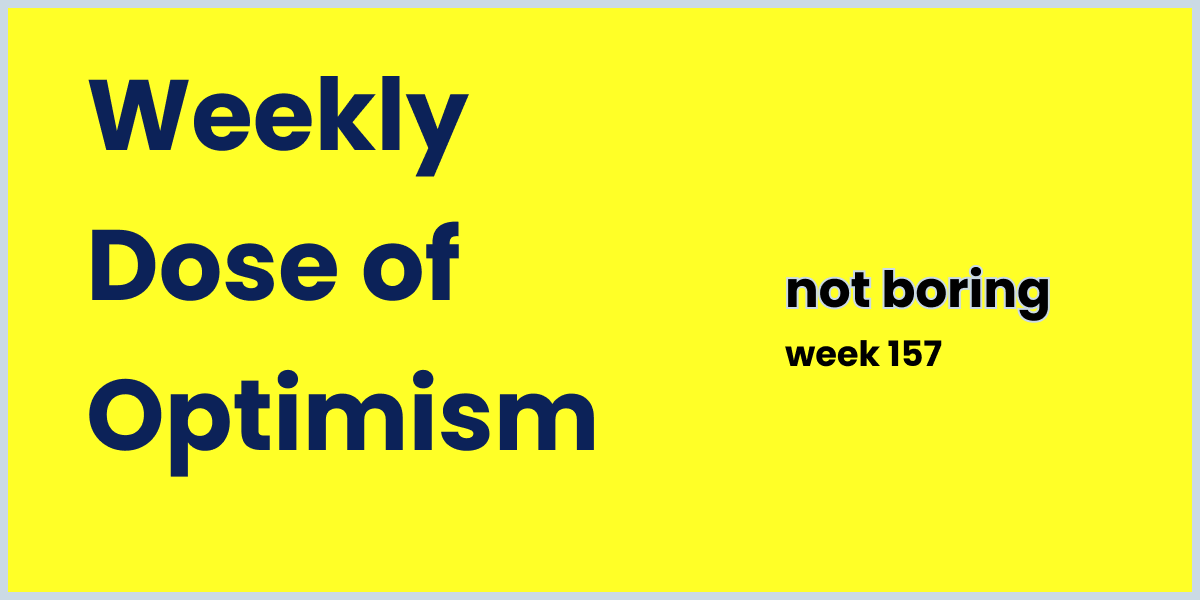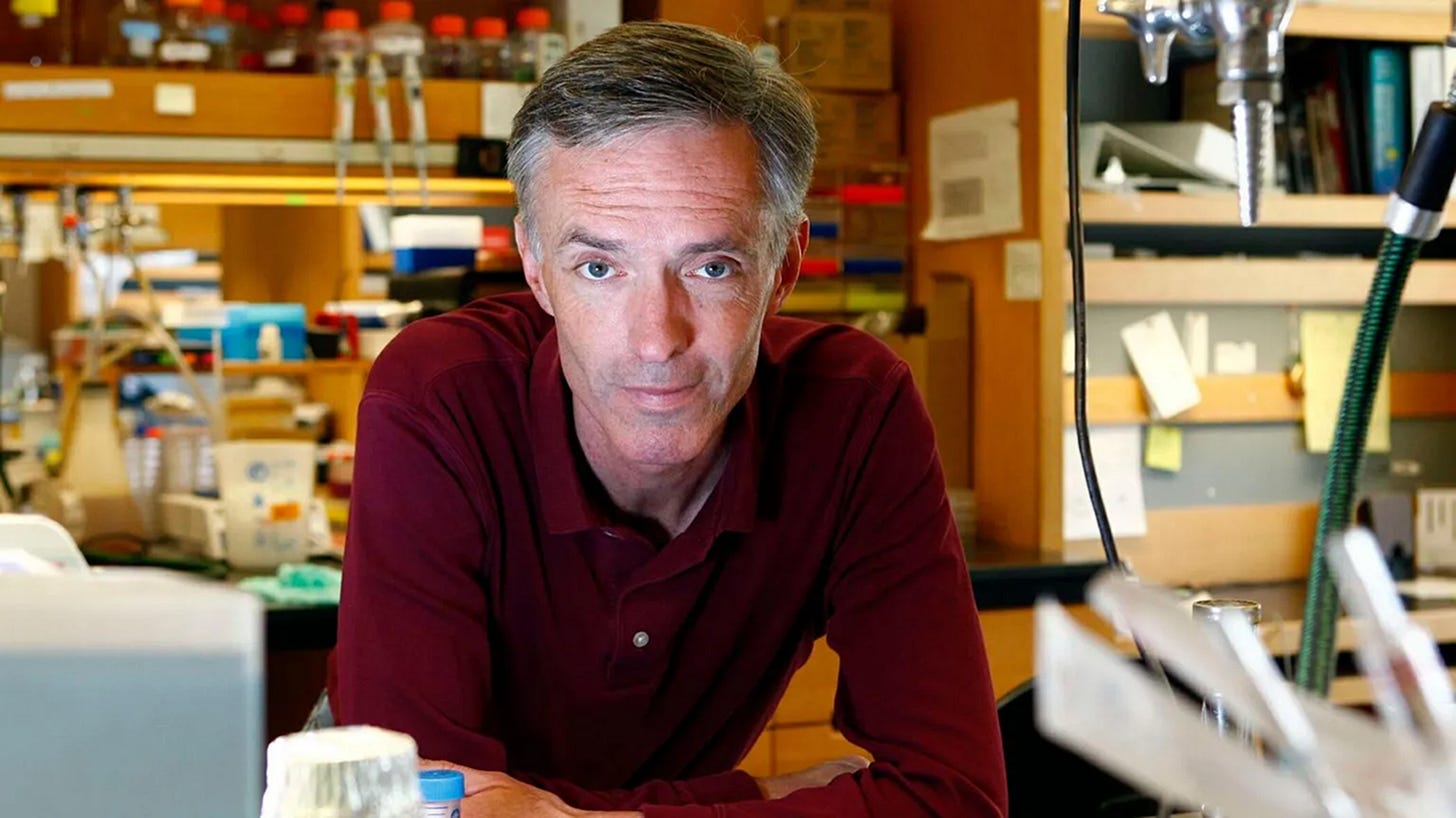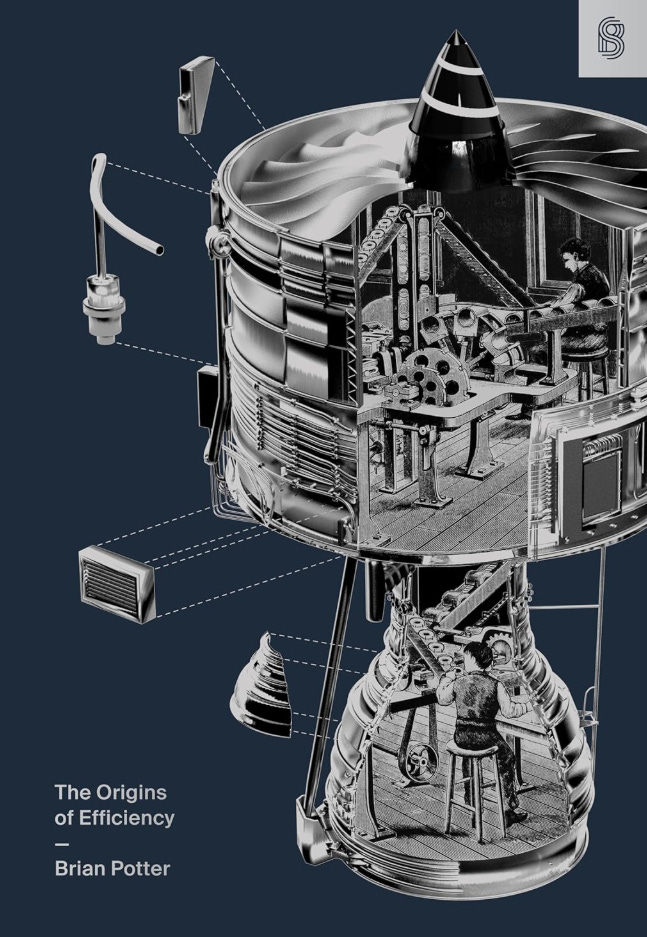Weekly Dose of Optimism #157
Advanced Nuclear, Vulcan Elemants, Rainmaker, Climate Catastrophism, AI-Designed Antibiotics + The Origins of Efficiency
Hi friends 👋 ,
Happy Friday and welcome back to our 156th Weekly Dose of Optimism. Packy here. Dan is out in California doing creatine gummy things so I’m filling in for him. This is also penance: I haven’t published an essay since Means & Meaning a couple of weeks ago, because I started writing what I thought was going to be a short essay and has become the deepest I’ve ever written. I hope to have it to you next Tuesday, but at this point, your guess is as good as mine.
So in the meantime, a lot of optimism. Really good week. The optimism gods smiled on me, made it easy. We have advanced nuclear reactors, rare earth magnets, cloud seeding, good news on climate, and AI-designed antibiotics. Not bad for mid-August!
Let’s get to it.
Today’s Weekly Dose is brought to you by… WorkOS
Get Enterprise Ready Without Slowing Your Roadmap
WorkOS brings enterprise features to your app in minutes, not months.
Add SSO, SCIM, and RBAC in a few lines of code.
Onboard customers instantly with a secure self-serve portal.
Trusted by OpenAI, Cursor, and Vercel to scale with confidence.
Focus on building what makes your product great. WorkOS handles the rest.
Make your app enterprise ready today →
(1) Department of Energy Announces Initial Selections for New Reactor Pilot Program
US Department of Energy
Seeking DOE authorization provided under the Atomic Energy Act will help today’s selected companies— Aalo Atomics Inc., Antares Nuclear Inc., Atomic Alchemy Inc., Deep Fission Inc., Last Energy Inc., Oklo Inc., Natura Resources LLC, Radiant Energy Inc., Terrestrial Energy Inc., and Valar Atomics Inc.
The race to critical advanced nuclear reactors by July 4th, 2026 is on and I don’t know who to root for.
This week, the Department of Energy announced its selection of eleven companies to participate in the New Reactor Pilot Program, which will expedite the testing of their designs at sites beyond DOE facilities.
Why is this important? In the piece I wrote on Radiant, we talked about the race to the DOME, a DOE testing site at Idaho National Lab. Getting to the DOME is important, because DOE sites have been the only place to test new reactors. Everywhere else, in order to let you test, the NRC wants to see data, which you can’t generate unless you test, which you can’t do unless you have data, which you can’t generate… you get the problem.
Now, these ten companies (I guess one has two projects?) will be allowed to test.
It’s an excellent group of companies, featuring one Not Boring Deep Dive subject (Radiant), five Age of Miracles guests (Matt Loszak of Aalo Atomics, Jordan Bramble of Antares, Bret Kugelmass of Last Energy, Jake Dewitte of Oklo, and Isaiah Taylor of Valar Atomics), a cool one I’ve gotten to know since the podcast (Deep Fission) and my Age of Miracles co-host, Julia Dewahl of Antares!
Meet them here:
(Pardon my face)
And here:
The country’s energy future is in good hands with this group. We’re gonna need a lot of TRISO!
(2) Rare-Earth Magnet Maker Raises $65 Million in Push to Counter China
Hannah Miao for WSJ
Vulcan, which said it previously raised about $10 million in seed funding, opened a pilot manufacturing facility this March in Durham, N.C., and has made initial magnets for military and commercial clients. Vulcan said it doesn’t use any material, equipment or software from China, only from the U.S. and its allies.
Speaking of startups solving critical challenges that America has ignored for too long… Vulcan Elements announced a $65 million raise led by Altimeter Capital to manufacture rare earth magnets fully decoupled from China.
John Maslin and team already have a pilot facility up and running in the America’s greatest city (Durham, NC) and have delivered fully decoupled magnets to customers. This round is going to go to a new facility, where they’ll scale up production to meet the seemingly bottomless demand for the neodymium magnets that are in everything from your iPhone to EVs.
Rare earth elements — at least the first four lanthanides, including neodymium — aren’t actually that rare. The ability to refine them and manufacture them into the powerful magnets that make the world spin is. China absolutely dominates this process; they produce over 90% of the world’s rare earth magnets.
Whether you believe war with China is imminent or you just believe that the US should be able to make electric things, being able to make neo magnets here is critical. Vulcan is America’s best shot at making that happen.
(3) Why Rainmaker is Fighting to Save Cloud Seeding
Abundance Institute x Jason Carman
Everybody that uses water stands to benefit from cloud seeding.
The Abundance Institute x Jason Carman partnership is the gift that keeps on giving.
I’m drawn to solutions to problems that don’t seem as neat as you’d want solutions to be - that don’t sound quite right - but that actually solve the problem. Nuclear provides clean, safe, abundant energy. Juul gets people to stop smoking. And cloud seeding can replenish dried out areas and support life.
In The Great Differentiation, I used Rainmaker as an example of a company whose brand was differentiated by the nature of what the company does. Jason captures that beautifully in this video. The best content you just can’t fake: like founder Augustus Doricko going around the country, educating state legislatures on the differences between cloud seeding and chemtrail conspiracies.
This video is a good look at the technology we have at our disposal to make life better for humans, and at all of the very non-technical, human-to-human things it takes to make sure that technology sees the light of day.
(4) Why I Stopped Being a Climate Catastrophist
Despite close to a degree and a half of warming over the last century or so, global mortality from climate and weather extremes has fallen by a factor of 25 or more on a per capita basis. As Pielke documented recently, the world is on track this year for what is almost certainly the lowest level of climate related mortality in recorded human history, not only on a per capita basis but on an absolute basis as well.
In 2007, Ted Nordhaus and Michael Shellenberger published a book on climate change called Break Through, in which they wrote:
Over the next 50 years, if we continue to burn as much coal and oil as we’ve been burning, the heating of the earth will cause the sea levels to rise and the Amazon to collapse, and, according to scenarios commissioned by the Pentagon, will trigger a series of wars over the basic resources like food and water.
Nordhaus wrote an essay this week in which he admitted he no longer believes that. “Yes,” he writes “the world will continue to warm as long as we keep burning fossil fuels. And sea levels will rise. About 9 inches over the last century, perhaps another 2 or 3 feet over the course of the rest of this century. But the rest of it? Not so much.”
At the time he wrote the book, he explains, he and most climate scientists believed that business as usual emissions would lead to 5 degrees of warming by the end of the 21st century. Now, he says, estimates have lowered to 3 degrees, not because we’ve done anything particularly well on the climate front, but because 5 degrees never made sense in the first place. That estimate was based on a trio of assumptions - “very high population growth, very high economic growth, and slow technological change” - that have not individually tracked with global trends and, he argues, don’t occur together.
High economic growth is strongly associated with falling fertility rates. Technological change is the primary driver of long term economic growth. A future with low rates of technological change is not one that is consistent with high economic growth. And a future characterized by high rates of economic growth is not one that is consistent with high rates of population growth.
If 5 degrees was catastrophic, 3 degrees should be cause for celebration, but “Climate advocates have arguably become more catastrophic about climate change in recent years, not less.”
Even more heartening, he links to an article by Roger Pielke Jr that suggests that “the world is on track this year for what is almost certainly the lowest level of climate related mortality in recorded human history, not only on a per capita basis but on an absolute basis as well.”
A big reason for that: we have gotten better at using technology to protect ourselves from a climate that can be naturally harsh to humans. A long time ago, our ancestors built houses and sewed clothes. More recently, we’ve developed heating and air conditioning. A heat wave or a harsh winter is not the mass death sentence it once was. When Malthus was worried we wouldn’t be able to feed a growing population, Haber and Bosch figured out how to make nitrogen fertilizer. Now, we might even be able to make it rain over farms that have been dried out.
None of this means that climate change isn’t real (it is) or that we should stop transitioning to clean energy (we should accelerate), but we should also celebrate the fact that this year, the climate is killing fewer people than it has in world history.
As I argued in The Morality of Having Kids in a Magical, Maybe Simulated World, the fear around climate change has been a blessing in disguise because it accelerates our transition to better energy sources and better electric products: “climate change is a very real challenge with very real negative impacts on people and the planet. But climate change is solvable, and by solving it, we unlock the next phase of civilization’s growth.”
Time to unlock.
(5) AI designs antibiotics for gonorrhoea and MRSA superbugs
James Gallagher for BBC discovered via AI Opportunity
But the Massachusetts Institute of Technology (MIT) team behind it say AI could start a "second golden age" in antibiotic discovery.
If people had sex anymore, this would be huge news!
Researchers at MIT used AI to design “atom-by-atom” two new potential antibiotics that could kill drug-resistant gonorrhoea and MRSA (methicillin-resistant Staphylococcus aureus). In lab and animal tests, the AI-designed drugs successfully killed the superbugs.
Gonorrhoea and MRSA are bad, but the bigger problem is that drug-resistant bacteria now kill over one million people per year. Humanity has gone a little antibiotics happy, and as we dose ourselves with the drugs, bacteria evolve and adapt. The next time we try to kill them with antibiotics, the antibiotics no longer work.
Using AI, the MIT team was able to interrogate 36 million compounds “including those that either do not exist or have not yet been discovered” to come up with non-drug-resistant solutions.
"AI can enable us to come up with molecules, cheaply and quickly and in this way, expand our arsenal, and really give us a leg up in the battle of our wits against the genes of superbugs," MIT Professor James Collins told the BBC.
These two drugs need years of refinement and trials before they can hit the market, and other AI-designed drugs will be similarly bottlenecked. There are regulatory and business model concerns to be worked through before these machines of loving grace cure everything that ails us, like, for example, would it make sense to build up a bench of antibiotics and send them through trials so that as soon as bacteria becomes resistant to one, we send in the next?
Either way, if we’re in an arms race against the superbugs, a tool that helps us experiment over superhuman amounts of data is a useful tool.
Thanks to Louis Anslow and his AI Opportunity for flagging this story.
Bonus: My Book "The Origins of Efficiency" is Now Available for Preorder
Brian Potter with Stripe Press
After several months of this, I was able to condense down the mass of information I had collected into a relatively simple framework: a small number of specific things you can do to make a process more efficient.
I’m a simple man. Stripe Press publishes something, I buy it. Brian Potter writes something, I read it. A cover features a drawing of a jet engine with an old-timey workshop inside of it, I judge the book by it.
When all three converge in one book? Come on. That’s Christmas.
Brian is one of my favorite writers on the internet. No one explains complex physical processes better. To understand what I mean, check out his blog, Construction Physics, or our conversation on Hyperlegible.
But before you do any of that, go pre-order his book. I did, and I’d bet that if you like Not Boring, you’ll love The Origins of Efficiency.
Have a great weekend y’all.
Thanks to WorkOS for sponsoring. Go get your company enterprise-ready to welcome WorkOS to the Dose!
We’ll be back in your inbox next Tuesday (hopefully).
Thanks for reading,
Packy + Dan








As usual, if "climate change is real", and "we should transition", then please go tell that to Silicon Valley VCs, because they trated "lower taxes" with "no more public funding or governance over anything related to the transition, replaced by the federal government using money to make sure noone is working on the issue".
We'll see how it goes, maybe energy transition will be worth it for enough companies that the market alone deal with it.
But it's wrong to say that "we did not do anything" to change from a +5°C forecast to a +3°C forecast. Some people did stuff. Some people opposed that stuff. Whoever prevails in the end will decide how things evolve (I'm not writing "how things end up", since it's not the end )
But at least it's becoming trendy again to make electricity with fission. Toi bad it's becoming "un American" to have an electric car, or electric stove, or electric heater, etc...
I do like your opening, “Really good week. The optimism gods smiled on me, made it easy."